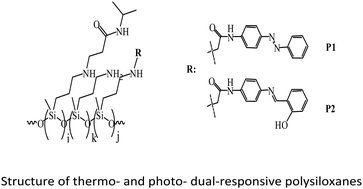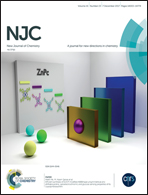Synthesis of thermo- and photo-responsive polysiloxanes with tunable phase separation via aza-Michael addition
Abstract
Two kinds of thermo- and photo-dual-responsive polysiloxanes (DRPSs) with functional pendent groups, N-isopropyl amides and azobenzene (Azo) or salicylideneaniline (SA), were synthesized through a facile, effective, and catalyst-free aza-Michael addition of poly(aminopropylmethyl-siloxane) with N-isopropyl acrylamide and N-azobenzene acrylamide or N-salicylaldehyde acrylamide. The chemical structrures of DRPSs were systematically characterized using FT-IR, H NMR and UV-Vis spectroscopy. The as-prepared DRPSs with lower Azo or SA contents exhibited lower critical solution temperature (LCST)-type phase transition in water, which is reversible and can be controlled by temperature and UV light. The effects of Azo and SA contents on the responsive properties of DRPSs are examined in detail. The LCST decreased with the increasing Azo or SA content. Once the content of Azo or SA reached up to 5.7% or 8.2%, respectively, DRPSs could not be dissolved in water even in an ice bath. Higher values of the LCST were measured after irradiation of the polymer solutions due to the higher polarity of cis-Azo and keto-SA conformation, induced by irradiation. The differences in cloud points between the irradiated and the non-irradiated DRPS aqueous solutions increased up to 3.4 °C and 9.8 °C when combined with 3.8% Azo and 5.8% SA units, respectively.



 Please wait while we load your content...
Please wait while we load your content...